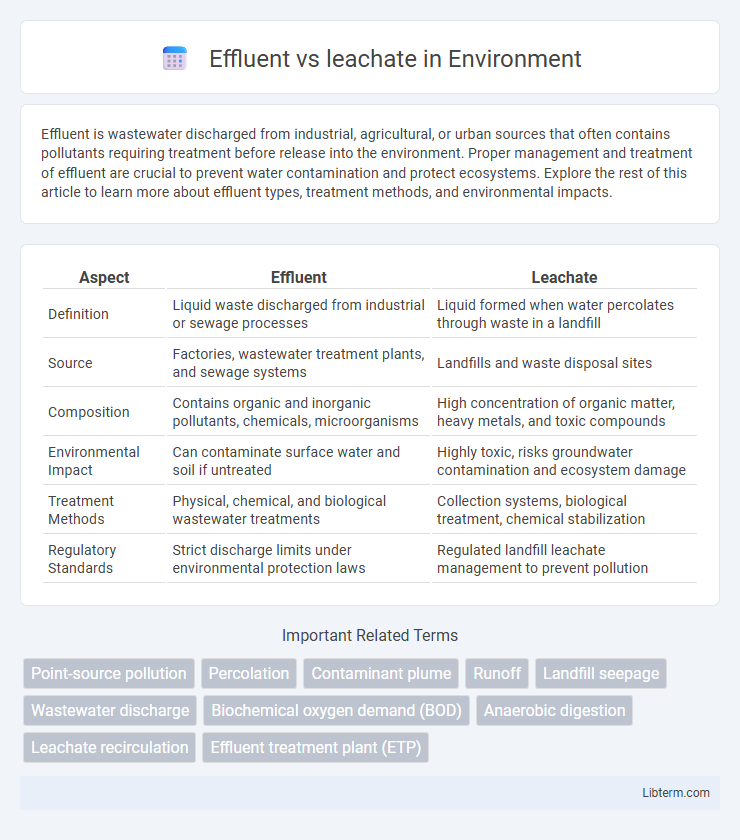Effluent is wastewater discharged from industrial, agricultural, or urban sources that often contains pollutants requiring treatment before release into the environment. Proper management and treatment of effluent are crucial to prevent water contamination and protect ecosystems. Explore the rest of this article to learn more about effluent types, treatment methods, and environmental impacts.
Table of Comparison
| Aspect | Effluent | Leachate |
|---|---|---|
| Definition | Liquid waste discharged from industrial or sewage processes | Liquid formed when water percolates through waste in a landfill |
| Source | Factories, wastewater treatment plants, and sewage systems | Landfills and waste disposal sites |
| Composition | Contains organic and inorganic pollutants, chemicals, microorganisms | High concentration of organic matter, heavy metals, and toxic compounds |
| Environmental Impact | Can contaminate surface water and soil if untreated | Highly toxic, risks groundwater contamination and ecosystem damage |
| Treatment Methods | Physical, chemical, and biological wastewater treatments | Collection systems, biological treatment, chemical stabilization |
| Regulatory Standards | Strict discharge limits under environmental protection laws | Regulated landfill leachate management to prevent pollution |
Introduction to Effluent and Leachate
Effluent refers to wastewater or liquid discharge from industrial, agricultural, or municipal sources released into the environment, often requiring treatment to meet regulatory standards. Leachate is a highly contaminated liquid that forms when water percolates through solid waste in landfills, picking up dissolved substances and pollutants. Understanding the differences between effluent and leachate is crucial for managing environmental pollution and designing effective waste treatment systems.
Defining Effluent: Sources and Characteristics
Effluent refers to wastewater discharged from industrial, municipal, or agricultural sources, characterized by its variable chemical and physical properties depending on its origin. Common effluent sources include factories, sewage treatment plants, and stormwater runoff, often containing organic matter, nutrients, heavy metals, and pathogens. Understanding effluent composition is crucial for effective treatment and environmental compliance to minimize pollution impact on water bodies.
Understanding Leachate: Formation and Composition
Leachate forms when water percolates through waste materials in landfills, dissolving various organic and inorganic compounds, resulting in a complex liquid that contains hazardous substances like heavy metals, ammonia, and organic pollutants. Effluent typically refers to treated or untreated wastewater discharged from industrial, municipal, or agricultural sources, which differs from leachate in origin and chemical makeup. Understanding leachate's formation and composition is crucial for designing effective waste management and treatment systems to prevent environmental contamination.
Key Differences Between Effluent and Leachate
Effluent is the liquid waste discharged from industrial processes or sewage treatment plants, typically containing diluted contaminants and released into water bodies under regulated conditions. Leachate, on the other hand, is the highly concentrated liquid formed when water percolates through waste in landfills, containing dissolved organic and inorganic substances, heavy metals, and potentially toxic compounds. The key differences lie in their origin, composition, and treatment methods, with effluent generally being pre-treated wastewater, while leachate requires intensive remediation due to its complex, toxic nature.
Sources and Environmental Impact of Effluent
Effluent primarily originates from industrial processes, sewage treatment plants, and stormwater runoff, containing chemical pollutants, heavy metals, and organic matter that degrade water quality. These discharges often cause oxygen depletion, aquatic toxicity, and eutrophication in receiving water bodies, disrupting ecosystems and posing risks to human health. Effective effluent management requires stringent treatment and regulatory compliance to mitigate adverse environmental impacts.
Sources and Environmental Risks of Leachate
Leachate originates from the percolation of rainwater through waste in landfills, carrying organic and inorganic contaminants that pose significant environmental risks such as groundwater pollution and toxic chemical release. Effluent typically refers to treated or untreated wastewater discharged from industrial or municipal sources, generally regulated to minimize ecological impact. The uncontrolled release of leachate can lead to severe soil and water contamination, threatening aquatic ecosystems and human health due to its high concentrations of heavy metals, ammonia, and pathogens.
Monitoring and Treatment Methods for Effluent
Effluent monitoring involves regular sampling and analysis of parameters such as biochemical oxygen demand (BOD), chemical oxygen demand (COD), total suspended solids (TSS), pH, and nutrient concentrations to ensure compliance with environmental regulations. Treatment methods for effluent typically include physical processes like sedimentation and filtration, chemical treatments such as coagulation and disinfection, and biological treatments involving activated sludge systems or biofilm reactors to degrade organic contaminants. Advanced monitoring technologies like online sensors and automated sampling systems enhance real-time water quality assessment, enabling prompt adjustments to treatment processes for optimal effluent discharge quality.
Leachate Management and Treatment Solutions
Leachate management and treatment solutions focus on the containment, collection, and purification of leachate generated from landfills and waste disposal sites to prevent environmental contamination. Key treatment methods include biological processes like aerobic and anaerobic digestion, physical-chemical treatments such as coagulation and filtration, and advanced technologies like membrane filtration and reverse osmosis. Effective leachate management systems are crucial for minimizing toxic pollutant discharge, protecting groundwater quality, and ensuring compliance with environmental regulations.
Regulatory Standards for Effluent and Leachate Disposal
Effluent disposal is regulated under environmental standards such as the Clean Water Act in the United States, which sets limits on contaminants like biochemical oxygen demand (BOD), total suspended solids (TSS), and nutrient levels to protect water quality. Leachate management follows stringent landfill regulations including the Resource Conservation and Recovery Act (RCRA) that mandates containment and treatment procedures to prevent soil and groundwater contamination from hazardous substances. Both effluent and leachate disposal require monitoring and compliance with thresholds established by agencies like the Environmental Protection Agency (EPA) to mitigate risks associated with industrial and municipal waste by-products.
Sustainable Practices for Minimizing Effluent and Leachate
Sustainable practices for minimizing effluent and leachate emphasize source reduction, advanced treatment technologies, and eco-friendly waste management strategies. Implementing constructed wetlands, bioreactors, and membrane filtration enhances contaminant removal while promoting resource recovery and water reuse. Integrated monitoring systems and green infrastructure reduce environmental impact by preventing pollutant discharge and encouraging natural attenuation processes.
Effluent Infographic

 libterm.com
libterm.com